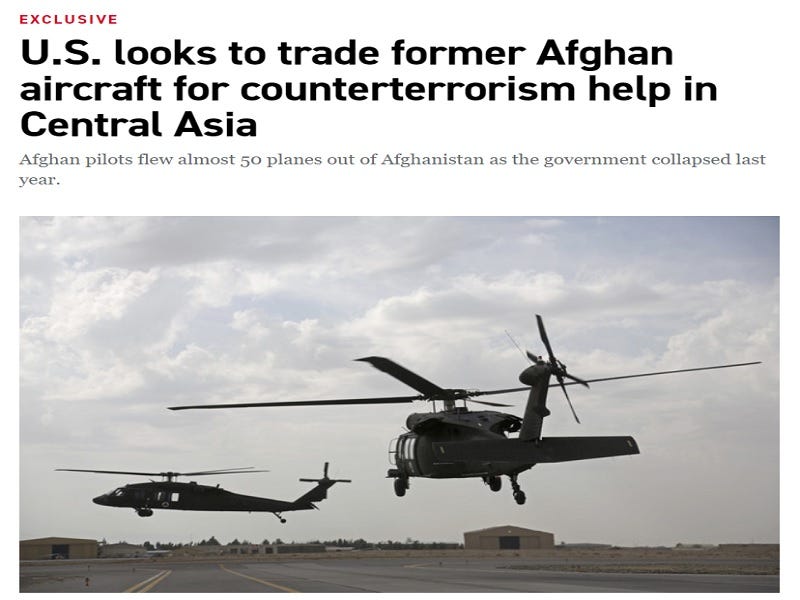America’s Scheme Of Swapping Afghan Aircraft For Central Asian Influence Is Admittedly Clever
Keeping in mind its envisaged role as a regional leader (which is complemented by its geostrategic position abutting Afghanistan and all Central Asian Republics), Uzbekistan is thus much more likely than Tajikistan to believe that secretly enhanced security ties with the US could bolster its Great Power balancing act.
Credit goes where it’s due, and America’s scheme of swapping Afghan aircraft for Central Asian influence is admittedly clever if Politico’s report about this is true. According to the outlet, two unnamed US sources informed them that Washington wants to let Tajikistan and Uzbekistan keep those US-supplied Afghan aircraft that the former government used to evacuate their country in exchange for informal border security and counterterrorism agreements.
Intelligence-sharing is at the core of this outreach since basing rights are unlikely for now (key qualifier) due to Tajikistan’s membership in the CSTO (which requires consensual approval to host non-bloc military infrastructure) and Uzbekistan’s constitutional prohibition on such foreign facilities. The larger context in which this latest report was published is that a US drone struck Afghanistan in early August, Russia warned about the US’ ulterior motives in the region, and Kyrgyzstan and Tajikistan clashed again.
It's that last development that might be why one of those unnamed sources told Politico that Tajikistan is “by far the most cooperative” on counterterrorism after already collaborating with the US on border security and training. It also deserves mentioning that this country is concerned about the Taliban’s treatment of its co-ethnics that inhabit Northern Afghanistan as well as the rise of ISIS-K on their frontier. The latest clashes with Kyrgyzstan might also have made Tajikistan disappointed in the CSTO.
Armenia is similarly disappointed in this Russian-led mutual defense alliance and some of its top officials even hinted that they were considering changing their country’s relationship with it, though falling short of confirming speculation that they planned to withdraw from the bloc. In any case, the precedent is already established for regional clashes contributing to a member’s disappointment in the CSTO, though it appears to be wishful thinking on the US’ part if it imagines that Tajikistan shares these views.
Having clarified that, it would make the most sense for Uzbekistan to be much more receptive to the US’ latest scheme and seriously consider building upon it than it does for Tajikistan. That’s because this country isn’t part of the CSTO, so despite its constitutional prohibition on foreign military bases, it could in theory either lease one of its facilities to the US or allow some of its troops to be stationed together with its own troops in one of their existing bases. Either workaround would result in the same outcome.
Another point to draw attention to is the “CASA (Central Asia-South Asia) Quad” that was created in July 2021 between the US, the South Asian anchor of Pakistan, and hybrid Central-South Asian state of Afghanistan, and the Central Asian Republic of Uzbekistan. February 2021’s agreement to build a Pakistan-Afghanistan-Uzbekistan (PAKAFUZ) railway represents the core geo-economic project of this structure.
Neither in and of themselves are destabilizing or troubling, but the problem comes down to America’s interests, especially after the post-modern coup that it successfully pulled off in Pakistan in early April. South Asia is now presently undergoing a grand strategic reorientation whereby America is rapidly reestablishing its hegemonic influence over Pakistan in parallel with India flexing its strategic autonomy, though the first-mentioned trend might still be offset if Imran Khan ever returns to office.
Unless that happens, then it should be taken for granted that the current trajectory will continue unfolding and Pakistan thus becomes the US’ hub of regional influence. From there, America is expected to take advantage of Uzbekistan’s role as the center of Pakistan’s “Vision Central Asia” to exploit PAKAFUZ’s objectively existing geo-economic basis as a cover for expanding military-strategic influence. In other words, public multilateral cooperation over this project could mask secret military cooperation.
Whether or not Uzbekistan ultimately hosts US forces in some capacity remains to be seen, but there’s no denying that the US’ newly restored hegemony over Pakistan after April’s post-modern coup combines with PAKAFUZ’s promising potential and Politico’s report to add credence to suspicions that the “CASA Quad” might be revived in a new geostrategic context. By cleverly dangling the carrot of keeping US-supplied Afghan aircraft, Washington wants to see exactly how far Tashkent is willing to go.
Tajikistan is also certainly interested in this too, but it’s limited by how far it can realistically go in this respect, especially considering how much more deeply entrenched Russian influence is there compared to Uzbekistan. Putting aside speculative disappointments about the CSTO after the latest clashes with Kyrgyzstan, Russian-Tajik relations remain strong and there’s no indication to suggest that they have any chance of going the way that Russian-Armenian ones regrettably seem to be.
Keeping in mind its envisaged role as a regional leader (which is complemented by its geostrategic position abutting Afghanistan and all Central Asian Republics), Uzbekistan is thus much more likely to believe that secretly enhanced security ties with the US could bolster its Great Power balancing act. That’s not to say that they’d result in this expected outcome since they might very well prove regionally divisive and thus counterproductive, but just that its leadership might seriously consider it.


